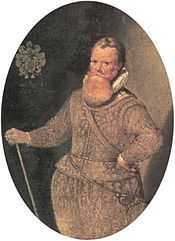Frederick de Houtman
| Frederick de Houtman | |
|---|---|
 Portrait by David de Meyne in 1617 | |
| Born |
1571 Gouda, Holland, Seventeen Provinces |
| Died |
21 October 1627 Alkmaar, Holland, Dutch Republic |
| Nationality | Dutch |
| Occupation | Explorer |
Frederick de Houtman (1571 – 21 October 1627), or Frederik de Houtman, was a Dutch explorer who sailed along the Western coast of Australia en route to Batavia, nowadays known as Jakarta in Indonesia. He made pioneering observations of the southern stars that contributed to the creation of 12 new southern constellations.
Biography
Frederick de Houtman was born in Gouda, Holland, Seventeen Provinces.
He assisted fellow Dutch navigator Pieter Dirkszoon Keyser with astronomical observations during his first expedition from Holland to the East Indies in 1595-1597.
During subsequent expeditions he added further stars to the list of those observed by Keyser. Between them the constellations at the bottom of this article are credited to them as discoverers.

De Houtman was the elder brother of Cornelis de Houtman who in a second expedition in 1598-1599 was killed. Frederick was imprisoned by the Sultan of Aceh in northern Sumatra, but made good use of his two years in prison by studying the local Malay language and making astronomical observations.
In 1603, after his return to Holland, Frederick published his stellar observations in an appendix to his dictionary and grammar of the Malayan and Malagasy languages.[1]
In 1619 he, in the VOC ship Dordrecht, and Jacob d'Edel, in another VOC ship Amsterdam, sighted land on the Australian coast near present-day Perth which they called d'Edelsland. After sailing northwards along the coast he encountered and only narrowly avoided a group of shoals, subsequently called the Houtman Abrolhos. De Houtman then made landfall in the region known as Eendrachtsland which previous explorer Dirk Hartog had encountered. In his journal, De Houtman identified these coasts with Marco Polo's land of Beach, or Locach, as shown on maps of the time such as that of Petrus Plancius and Jan Huygen van Linschoten.[2]
De Houtman died in Alkmaar, Holland, Dutch Republic.
See also
References
- ↑ Fr. de Houtman, Spraeck ende woord-boeck, in de Maleysche ende Madagaskarsche talen, met vele Arabische ende Turcsche woorden. Inhoudende twaelf tsamensprekeninghen inde Maleysche, ende drie in de Madagaskarsche spraken, met alderhande woorden ende namen, ghestela naer dordre vanden A.B.C. alles int Nederduytsch gestellt: noch zijn hier byghevoecht de declinatien van vele vaste Sterren, staende ontrent den Zuyd-pool (Amsterdam: Jan Evertsz. Cloppenburch, 1603) online link.
- ↑ Letter of Commandeur Frederik de Houtman to the Chamber Amsterdam, 7 October 1620, Algemeen Rijksarchief, The Hague, 982, 1620 II, fol147-151, fol.148r; quoted in P. A. Leupe, De Reizen der Nederlanders naar het Zuidland of Nieuw-Holland in de 17e en 18e eeuw, Amsterdam, G. Hulst van Keulen, 1868, p.29, 32; cited in Frederik Willem Stapel, De Oostindische Compagnie en Australië, Amsterdam, P.N. van Kampen, 1937, pp.11 en 28.
- "VOC Historical Society Inc: The exploration and mapping of the Australian coastline in the seventeenth and eighteenth centuries". Retrieved 2006-04-09.
- Ian Ridpath's Star Tales
- Knobel, E. B., "On Frederick de Houtman's catalogue of southern stars, and the origin of the southern constellations",Monthly Notices of the Royal Astronomical Society, Vol. 77, p. 414-432. (ADS)
| |||||
|